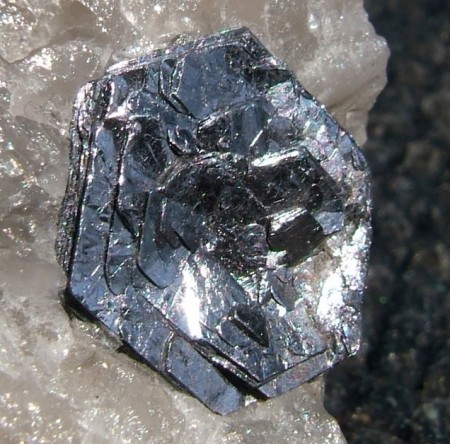Nov
18
Molybdenum Disulfide Joins Graphene As a Wonder Material
November 18, 2014 | Leave a Comment
Atom thick sheets of material got researchers rolling when graphene was first produced in the lab in 2004. Literally thousands of laboratories began developing graphene products worldwide. The graphene attributes amazed researchers with its lightweight and ultra-strong properties. Time and research have added conductivity and other attributes.
Now a decade on scientists are now searching for other materials that have the same level of potential. Molybdenum disulfide is at the top of the list and may have even more potential.

Molybdenum Disulfide in its Natural State. Image Credit Wikipedia Commons. Click image for the largest view.
Mark Hersam, the Bette and Neison Harris Chair in Teaching Excellence at McCormick, who is a graphene expert said, “We continue to work with graphene, and there are some applications where it works very well. But it’s not the answer to all the world’s problems.”
Molybdenum disulfide (MoS2) is part of a family of materials called transition metal dichalcogenides and is emerging as a frontrunner material for exploration in Hersam’s lab.
Like graphene, MoS2 can be exfoliated into atomically thin sheets. As it thins to the atomic limit, it becomes fluorescent, making it useful for optoelectronics, such as light-emitting diodes, or light-absorbing devices, such as solar cells. MoS2 is also a true semiconductor, making it an excellent candidate for electronics.
MoS2 has been in use a long time, historically has been used as a dry lubricant and in catalysis to remove sulfur from crude oil, which prevents acid rain.
Hersam’s challenge was to find a way to isolate atomically thin sheets of MoS2 material at a larger scale. For the past six years, his lab has developed methods for exfoliating thin layers of graphene from graphite, using solution-based methods at large scale.
“You would think it would be easy to do the same thing for molybdenum disulfide. But the problem is that while the exfoliation is similar to graphene, the separation is considerably more challenging,” he said.
To sort graphene layers, Hersam used centrifugal force to separate materials by density. To do this, he and his group added the material to a centrifuge tube along with a gradient of water-based solution. Upon centrifugation, the denser species move toward the bottom, creating layers of densities within the centrifuge tube. Graphene sorts into single layer sheets toward the top, then bilayer sheets, trilayer, and so on. Because graphene has a relatively low density, it easily sorts compared to higher density materials.
“If I use the exact same process with molybdenum disulfide, its higher density will cause it to crash out,” Hersam said. “It exceeds the maximum density of the gradient, which required an innovative solution.”
Hersam needed to take the inherently dense material and effectively reduce its density without changing the material itself. He realized that this goal could be achieved by tuning the density of the molecules used to disperse MoS2. In particular, the use of bulkier polymer dispersants allowed the effective density of MoS2 to be reduced into the range of the density gradient. In this manner, the sheets of MoS2 floated at layered positions instead of collecting as the bottom of the centrifuge tube. This technique works not just for MoS2, but for other materials in the transition metal dichalcogenides family.
“Now we can isolate single layer, bilayer, or trilayer transition metal dichalcogenides in a scalable manner,” Hersam said. “This process will allow us to explore their utility in large-scale applications, such as electronics, optoelectronics, catalysis, and solar cells.”
Molybdenum disulfide has always had a bright future, its amazing stuff with very attractive qualities at the micro scale. At the nano scale, catalysis, electronics and the soon to take off optoelectronics field, MoS2 looks like an important material for reducing the energy used to accomplish more work at lower cost.

